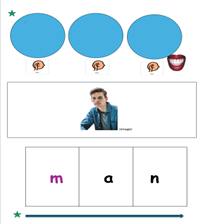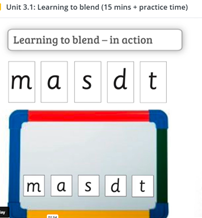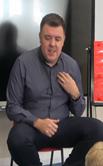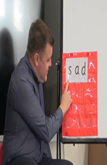Getting Them Blending by Christmas: Strategies for Success - Janet Thompson (Literacy Specialist)
Why is Blending Important?
Blending—the process of pushing sounds together to form words—is a crucial milestone in early literacy. The sooner children can blend, the sooner they enter the world of reading. Learning the “code” of sounds has little value if children can’t use it to decode words.
The Challenges
Many children enter school with barriers such as developmental delays or difficulties tuning in, repeating, and recalling sounds. These challenges can slow their progress in blending. Many children can listen to and repeat words in everyday contexts, however, they often struggle to identify individual sounds within those words—a skill known as "sound talk." The game of ‘I Spy’ is a great game to introduce the skill of listening out for the initial sound of a word. Teaching children to isolate, hear, and say sounds bridges the gap between recognising spoken words and developing oral blending skills. This is where Nursery and Reception meet.
Building a Foundation
Strong phonemic awareness is crucial. The exposure to rhymes, songs and alliteration like the good old Letters and Sounds phase 1 approach and purely playing with sounds actually does help train the brain, lay a blueprint for the orthographic mapping of the sounds in words.
Using “mmmmmmmm…..aaaaaaaaaa….nnnnnn” as ‘man’ helps children to tune in.
The more exposure; the deeper the imprint. Eventually, the brain retains the sounds as they begin to hear it, repeat it, and then isolate ‘mmmm’… for ‘man’. More so, it helps memory recall and processing. If we can’t recall 2 or 3 things how can we blend a CVC word? In a rush to get them blending, don’t forget to strengthen or even build the memory, recall and processing skills. This may be their individual barrier to blending.
Scaffolding Strategies
- Repeated Exposure
Repeated exposure is key, and the penny does eventually drop. After all, think how quickly toddlers accidentally pick up swear words—they hear adults repeat them, retain the sounds, and echo them at the most inconvenient moments!
Children benefit from repeated exposure (which is 4-5 times in the moment), explicit instruction and repeated spaced out learning of blending. One input a day just won’t make have the desired impact. A Dyslexic learner needs 10x more, so around 40- 50 exposures. To alleviate cognitive overload, ensure children are secure with the alphabetic code before blending with it. For example, before blending the word ‘bed’ we need to be secure in our knowledge of the sounds ‘b’, ‘e,’ and ‘d’.
- Use Visuals
Struggling blenders often do better when a visual is used, which is also good support for EAL children and developing oracy skills too. Begin with the word… ‘man…. man’ supported by a visual, it immediately sets the goal and makes the process more achievable. Many schemes now publish sound blending books with a visual on one side as a scaffolding tool to support learners.
- Slow to Fast
Start with slowly blending, stretching out the sounds – “mmmmmmmmmmm….aaaaaaaaaa…..nnnnnnn”.
Then repeat severla times, getting a litter faster each time:
“mmmm….aaaa…nnnn”
“mm…aa..nn”
“m..a..n”
“man”
Finish by saying the word twice to affirm and embed, using smiles and eyes for praise. For automaticity encourage them to sound talk and blend several times. Model, then get the children to repeat the steps. Some children will benefit from extra processing time during the pauses between each sound. Just ensure the word is repeated and stretched as one unit so they end by blending/pushing the sounds together for a whole word.
- Concrete resources
If sounds just ‘hang’ in the air it is often too abstract for many, particularly if spacial awareness is a barrier. Blending boards and using counters to represent the sounds, or pointing with the finger or a toy car to aid the left to right blending of sounds is useful and used in many SEND settings. As adults we can think, process and order the sounds into a word but until that part of the brain has been trained, oral blending with no use of gesture, visuals or graphemes to organise the sounds makes it more challenging to master. Blending needs to be concrete, repeated, structured and explicitly modelled, done together then the penny drops and children blend.
Effective Teaching Strategies
- Using Sound Cards
Another key part of the blending journey is making words with separate sound cards, before tackling whole word flash cards. Start with orally blending, then model on a large scale with individual sound cards, model again on a smaller scale (again with individual sound cards), then the children have a go. This technique is so powerful as the repeated use of modelling strengthens the brain’s capacity to retain the sounds. Once children have made the word, get them to keep sound talking and reading their word to help develop their fluency and automaticity.
Orally blend Model large Model again Children make ‘sad’
- I Do, We Do, You Do
Model blending explicitly:
I do: The teacher models blending.
We do: Teacher and child blend together.
You do: The child practices independently.
- Again!
Very simple but highly effective, is the use of ‘again’. It can be used as a form of praise, with your eyes saying ‘ brilliant’ while also enabling the child to repeat so the art of blending becomes automatic and effortless. Never anything once!
- Make the Most of Every Moment
Sound talk constantly throughout the day: when the children are lining up, playing within the provision, during the register etc. For example “put your c-oa-t on your p-e-g.” or play Simon Says “Can you touch your ch-i-n?” Any moment you can! Get all practitioners on board too- it is a team effort.
Teaching blending can feel like a long journey and for some it may well be, but the key lies in consistent, explicit modeling and scaffolding. With tools like sound talk, visuals, and structured routines, we can prepare children to hear, retain, and blend sounds. Our persistence as educators will make the difference, helping every child become a proficient blender.
By Janet Thompson - Literacy Specialist aka Phonics Ninja!






